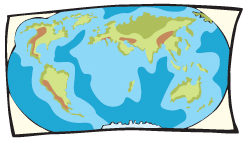 Photographs
Photographs
Photographs allow geographers to see actual features of the landscape. They can be taken on the ground (ground perspective) and from the air in an airplane (aerial perspective) or from high above the earth by a satellite. Satellite photography reveals topography and may also be used to study weather.
Graphs
Graphs represent quantitative relationships between variables, and provide a framework for statistical analysis. In geography, these variables may consist of populations (of people, plants, or animals), locations and their characteristics, time, and amounts. Types of graphs include bar graphs, line graphs, and pie charts.
Measuring tools
Measuring tapes are used to measure short distances. A theodolite comprises a telescopic lens and a spirit level (used to show how level something is) on a tripod, and is used to measure altitude and longer distances than can be measured with a measuring tape. A theodolite can also be used to measure vertical distances (sometimes, a tool called a plumb line is used for this). To measure various aspects of weather, rain gauges, hygrometers (which measure humidity), barometers (which measure air pressure), and wind vanes (for wind direction) and anemometers (for wind speed and direction) are used.
Geographical Information System (GIS)
GIS is a massive database for storage, separation, and analysis of geographical data. GIS can layer information specific to particular questions: this makes patterns and relationships more visible by excluding extraneous data. It can provide database, model, and map views.
GPS
GPS stands for Global Positioning System, a network of orbiting 24 satellites maintained by the US government that provides time and location information anywhere in the world.